Multi-Screen/Output Workflow
Table of Contents
With the latest addition and changes we made to the way Ventuz can handle outputs and to the possibility to previsualize content, there is a need for a more general overview of the workflow. The concept seems to be complicated in first, but you will realize that these changes will offer you an absolute stunning and unique way to get your content to the lit pixel! You will find even more detailed information about each topic, node and so on in the user manual and we will link whenever possible to the relevant pages.
Introduction
We will get you closer to the concept behind Ventuz- its new ways of using layout features, its new Nodes, previsualization and mapping. This includes using single screen, multiscreen, traditional single GPU- and MultiGPU systems (MGPU).
Basic Principles
The traditional way would be to just setup the project and its dimensions, create the content in the Ventuz Designer and then use the Configuration Editor, better, the Render Setup Editor inside, to setup the machines and map the outputs to the screens. Yes this is still possible but we added a lot more features and have slightly different terms.
Per default we have our Content created with the designer, even without knowing it, this Content has been put on a so called (default)Composition. If it comes to the part where we want to Output the Content we would need to assign a Screen to show the Content on. Keep in mind this Screen is Machine/GPU.
This diagram show the traditional workflow of a content which is mapped in the Render Setup Editor to 2 Cluster, which have one part of a videowall connected:

All the mapping and assignment in this case will happen in the Render Setup Editor. There you can simply map the content directly to machine(s) their Output(s) and therefore physical screen(s). You can cut the content and split it up to be assigned to different physical screens and so on and so forth.
Another way, which is now possible in Ventuz is to have a previsualization scene, short previs scene, created. This way you would create a 3D Environment in the Ventuz Designer and position your Screens in the 3D World. By doing so will have some benefits like you would not need to do the layout in the Render Setup Editor. Also you can use the combination of Compositions, Canvas and Previs Nodes to your advantage since the layout happens more in a visual way:
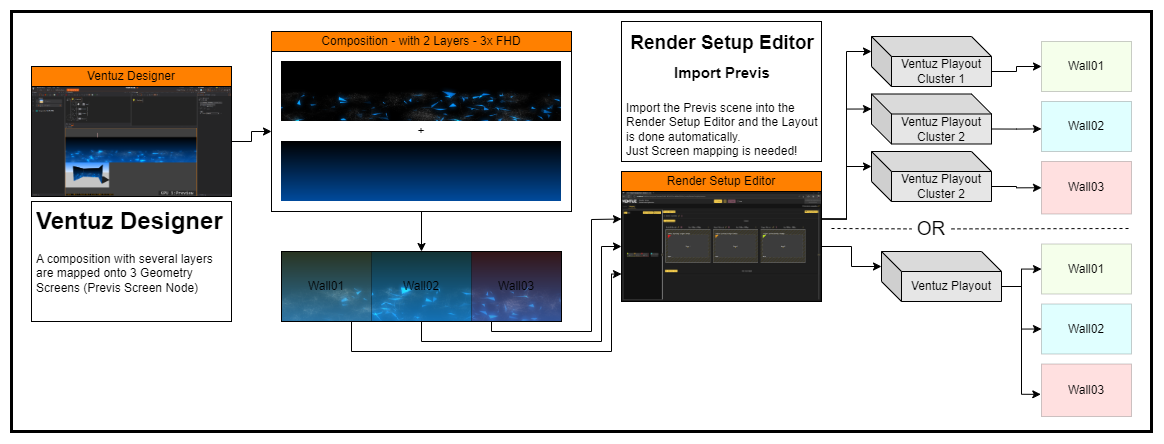
As you can see by the above diagram, you would only need to previsualize a scene, create the Screens, assign the Composition to the according Screens. As soon as you enter the Render Setup Editor you can import the previs-scene and the Render Setup Editor automatically layout the Screens for you. In our example from above the Render Setup Editor has imported 3 separate screens (Wall01...Wall03) and switches to the Mapping View. Here you just need to assign or map the Screens to the machines or their outputs.
We have thrown the term (default)Composition in the room.
As we have seen we have still the option to use the traditional workflow available. But from now on you can see the Content in a more wider aspect of things. You can *Composite* your Content together and show the resulting Composition on individual physical screens or outputs and also in different resolutions. Also you could Cut out parts of the Composition and so on.
Break down of elements
Lets try to break down each element which can be used in any of the possible workflow and explain it in detail, we start at the Ventuz Designer part:
Content
Content can consist of any kind of visual stuff. Can be a 3D Layer or 2D Layer basically anything you have created visually. You can throw together 3D Models, have a nice Background, something that is really appealing. We define content as anything that is visual here.
Composition
The composition is a combination of all visual elements which are, for example, several 2D and 3D Layers. A Composition can be either set to have automatic dimensions and will therefore adjust itself to the needed output depending on the chain behind - like the project resolution or the resolution of the mapped output.
You can also manually set the composition design size resolution and in combination with a Previs Canvas, position the Previs Screen cut more easily.
Since you use a Previs Screen, this screen will automatically be available for the Render Setup Editor and is ready to be mapped to a machine or output.
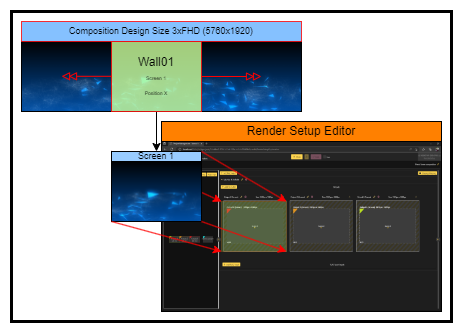
The Composition(s) in this case will be used on a Previs Canvas:
Previs Canvas
The Previs Canvas lets you put all the Composition(s) together and set their positions. Think about a real Canvas where you arrange all your visual elements on. One Composition can be made of a house of a tree, the other Composition is the mountains in the background, the lake in the foreground... All these Compositions can be put on a Canvas, arranged and scaled to form the whole picture.
In Ventuz you are able to do the same. So we have a Composition with the nice blue background and the nexus particle. That one spans the whole 2 Screens - the whole wall. Now we have another Mesh which we want to position on only one of the Screens/Walls. So we take the Composition which has the mesh and position that one on the Canvas. You can use different modes to blend these Compositions, based on Alpha for example.
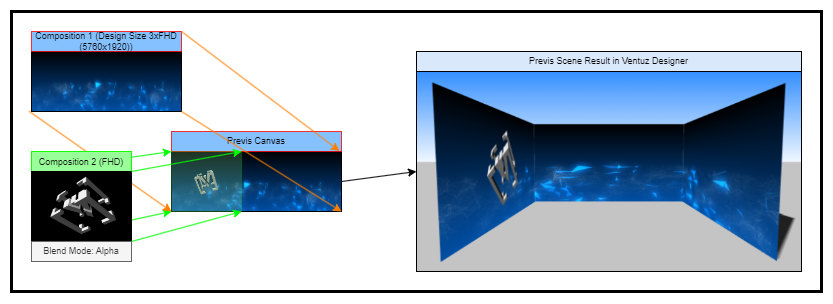
You see the Previs Canvas can be used to arrange multiple compositions which then get applied to Previs Screens:
Screens
Not the real ones, lets talk about the Previs Screens. These Screens have a Composition bound to them and previsualize then. As seen above, you can have multiple Compositions blend. This is the most common use case. Another thing to understand in the whole chain is how to work with the Previs Screens and make use of manual rectangles. What is needed often is to have a Composition shown on an array of LED-Tiles. So in case your LED-Wall is made of several tiles which are arranged in a pattern. Usually your LED-Tiles have given pixels - in the below example we have 220x220 pixels for each physical LED-Tile. We have arranged them in a shape of a 'V'. You could create your content in a Composition, apply it to a Previs Canvas and then arrange the 'V' shape by using a Screen with manual rectangles, which represent your physical LED-Wall-Tiles.
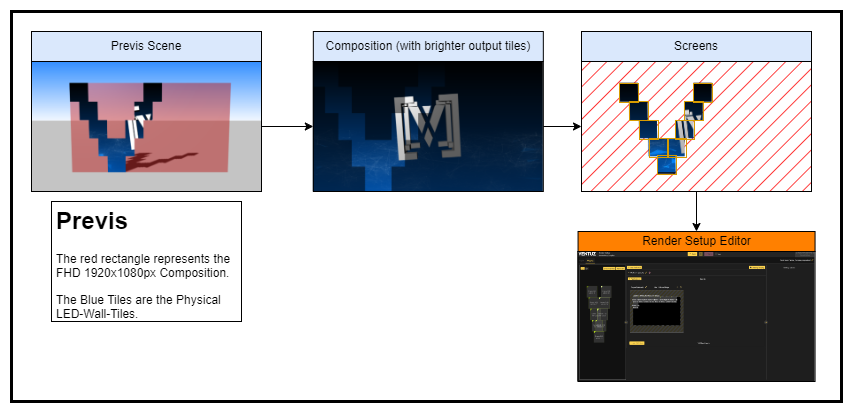
Render Setup Editor
At the first glance it looks overwhelming to have so many small Previs Screens rectangles which result and show up in the Render Setup Editor as 9 Screens. The idea behind is now to have all the screen-tiles arranged and mapped to a single Output. Thank to the drag&drop operation this is done very quickly. All you would do is drag and drop the screens onto an output, while later working with the LED-Controller, you would map the according Cuts to the desired LED-Tile.
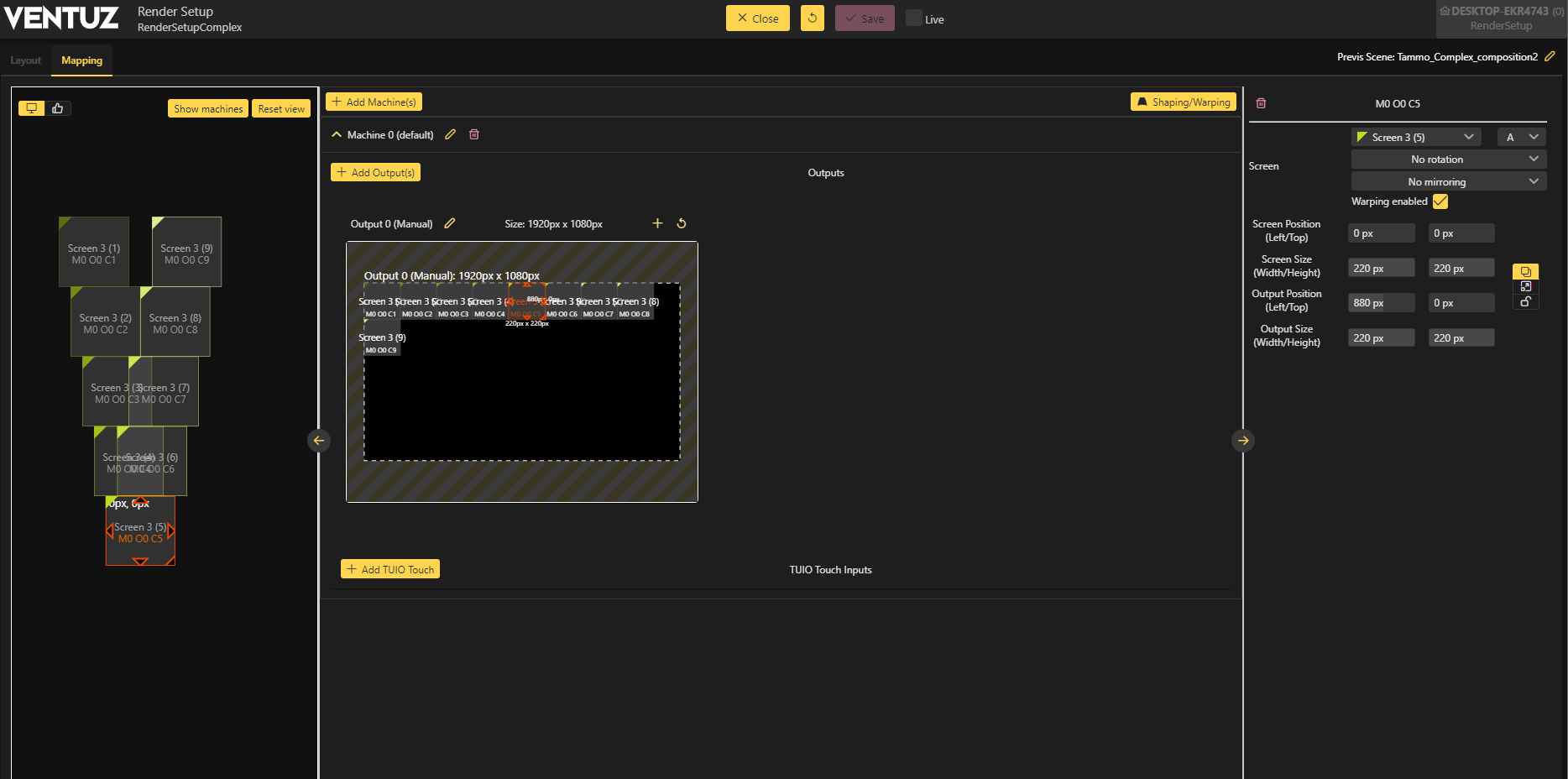
The below diagram shows an example of such a mapping workflow. Keep in mind the single output is set up for full hd (1920x1080px) and the LED Tiles just use 220x220px each, therefore there is some space in the output left. One could fill up the rest of the unused output space with other content from other Screens. This way you can assign several Screens to the Output and use all the available resolution from the output.

Aside from that you can use these Cuts and distribute them onto different Outputs or Machines.
Conclusion
You have several ways of using the Ventuz Output Chains. The one way would be to follow the traditional route to configure and map everything inside the Render Setup Editor. The other would be to have Previs Screens used, not only to have a real previsualization, but to safe the time for resolution value configuration and setup. Its very easy and straight forward to import the previs scene in the end and you would skip the layout part. The layout was already done and solved during the previsualization phase in this case. You have an absolute high flexibility by mapping content, assign it to screens and distribute it to several outputs and or machines.